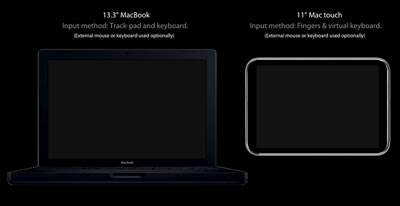Back in January of 2008 Architosh reader Brendan Sheehan put together a thoughtful artistic rendering of a possible future Apple Mac touch device. Today we’ll see just how far off he was. We have posted that image below but we are pretty sure Apple’s device announced today will be both similar and yet startlingly different than Sheehan’s image.
The 2008 Mac touch Concept
Let’s recap the 2008 January details of what we imagined (both Sheehan and Architosh) the future touch-based device would be like. Here were are essentials:
- Apple multi-touch based input
- 11 inch sized screen
- iPhone like front device appearance
- solid state memory (64-128 GB)
- Intel-based primary CPU
- ATI graphics
- ARM secondary processing unit
- modified Mac OS X operating system
In the last two years we have learned quite a bit of information that makes this earlier attempt at imagining the Mac touch incorrect. For starters, as we look at the list above, it is the second half of those bullet points that get very particular and hence very subject to change. Yet some of our concepts about “use” are likely spot on.
The Updated View
First of all in terms of a name Apple will likely surprise us this time. iSlate, iTablet, iScreen, Mac touch…unlike the iPhone name, which was obvious, there is no single name that makes perfect sense. One name that hasn’t been bandied about too much is iPad. This harks back of course to the Newton MessagePad, which Steve Jobs despised. The word “Pad” is likely not in the upcoming product name. If we hark back further we can look at Apple’s Juggarnaut Design Investigation which studied a touch-based device this size and that device was given the name WorkCase. There are just so many possibilities…we’ll just have to wait and see!
Getting back to the details we can now make some 2010 revisions to our 2008 ideas. Here is what Architosh believes will likely be introduced today:
- 10 inch computer screen, touch-based (Multi-touch)
- next-generation iPhone OS (which itself is a variant of the basis of Mac OS X)
- ARM-Architecture CPU (in-house Apple design a very real possibility here!!)
- Imagination Technologies GPU (PowerVR variant)
Further Details on Apple’s Announcement Today
We stick to our belief that the new touch based device will be able to serve two very distinguished groups of users who do not need the true-typing experience that can only be found on a laptop. We said this two years ago and we stand by this assumption for this new product. So let’s recap these groups and how the new device fits them:
Group One: Media Consumers
As we mentioned before we believe that “consumer computing is now the place where the ledging edge now exist” and this has only grown stronger since that last article. The new Apple tablet device will be a game-changer in software and a best-in-breed in hardware for this category. Expect more or less all of this:
- Direct Kindle competition: Apple will change the rules about how we obtain and consume the written word (books, magazines and maybe webzines) in much the same way they did with music with iTunes.
- Gaming: Apple’s iPhone is a stunning success in the world of gaming and the new tablet device will continue to push this success even further. Leading edge OpenGL ES combined with superior best-in-breed GPU hardware (Imagination Technologies?) and innovative API in the OS will propel this device forward.
- Movies, TV and Music: As we emphasized before a wired connection to iTunes on the computer (a la AppleTV) can make the slate device a great movie watching screen in bed or on the couch.
Group Two: Professional Vertical and Education
We also said that light typers need a device that is touch based and is ideal for the field. This means medicine, science, field workers in many industries, including AEC (architecture, engineering, construction) to education. We don’t see Apple emphasizing this today but the fundamental technologies that are there for gaming will make this a great platform for many of these vertical professional applications.
- Architecture, engineering and construction (AEC). This industry needs a great touch-screen with pen-input option platform badly. Viewing a big book is really no different than viewing a big set of construction drawings. Multi-touch opens up so many possibilities.
- Medicine is an ideal place for the new tablet from Apple. Doctors today already use the iPhone and iPod touch for similar use today
- Sciences: field and lab can utilize a touch-based device
- Field workers in all industries today rely on a multitude of platforms but none of them have the promise and capability of the iPhone OS and eco-system of software development and distribution
Closing Comments
Apple’s future will be revealed at 1:00pm EST as Steve Jobs hits the stage in San Francisco. It will be exciting to see what he introduces. We know that Apple has been working on a fifth product category for many years because Jobs said so years ago.
What will really be stunning today is if Apple has based the device on its own silicon design–namely that it has utilized its PA Semi group it acquired a few years ago to design a custom ARM Architecture main processor (CPU). This will mark a big moment for Apple for it will mean that the company is willing to compete with Intel and other semi-conductor designers head-to-head in order to differentiate itself from its competition.




Reader Comments
Comments for this story are closed